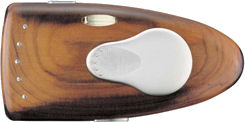 Olympus: Prototype wood-bodied digicam
Olympus: Prototype wood-bodied digicam
By
Michael R. Tomkins, The Imaging Resource
(Monday, September 25, 2006 - 04:06 EDT)
Olympus Japan has today announced that it will be exhibiting the first result of a newly developed process at the Photokina trade show.
According to the company, it has developed a new three-dimensional compression molding process that offers approximately 2.0 to 2.5x compression of cypress wood. The resulting material is said to offer approximately the same hardness as ABS and polycarbonate materials generally used in electronic component casings, as tested with the Vickers hardness test.
The molding technologies used were apparently developed for production of lens components, and the wood can be made thin enough for use in housings of devices like digital cameras. The company is to exhibit a prototype wooden digital camera body with styling somewhat akin to the Stylus Verve digital cameras on its Photokina booth.
More details in the press release below. No information is yet available on other areas such as stain / water resistance, etc.
|
Original Source Press Release:
|
Olympus develops new 3-dimensional compression molding process for wooden materials
Olympus Corporation (President: Tsuyoshi Kikukawa) is pleased to announce the development of a three-dimensional compression molding process for wooden materials. The new process draws extensively on Olympus expertise in precision metal-forming technologies. The processed wooden material has the feel and grain pattern of natural wood, but is much harder than engineering plastics such as ABS and polycarbonate resins*. Strong enough to be used to create the outer casings of electronic products, the material can enhance the aesthetic value and pleasure of ownership that those products provide.
*1 In-house testing using the Vickers hardness test; comparison samples were ABS and polycarbonate resins of the type normally used to produce electronic device casings.
Development Background
The efficiency, convenience, and lower costs associated with mass production technologies have inundated us in a sea of products. But at the same time, there has been a decline in the aesthetic satisfaction that many of those products provide. So we stepped back to consider what we could do to increase the aesthetic satisfaction that products provide.
One answer was to use wood, the natural color, patina, and grain of which are almost universally appreciated as things of beauty.
We therefore focused on the idea of using a three-dimensional compression molding process to produce a wood-based material thin enough and hard enough to be used to make the casings for electronic products.
With the successful development of this process, it is our hope that consumers will enjoy greater aesthetic satisfaction and a sense of personal attachment with future products that are made from this new wood material.
Details of the New Technology
Hardness that exceeds engineering-grade resins at a thickness that can be used to produce casings for electronic products
Using the newly developed three-dimensional compression molding process, the specific gravity of a piece of cypress wood was increased from approximately 0.4~0.5 to more than 1 (approximately 2.5x compression). The resulting material is thin enough to be used as a casing material for electronic products, yet is much harder than the ABS and polycarbonate resin-based engineering plastics that are normally used to produce such casings.
It is this special three-dimensional compression molding technology that enables the material to be used to make electronic product casings.
The feel and grain pattern of wood, with an attractive natural patina
Proprietary Olympus molding technologies developed for the production of digital camera, microscope, and endoscope lenses are used to form the wood material into the desired shape. The application of these high-precision molding technologies to wood compression molding results in an attractive natural patina that significantly reduces the need to post-process the material.
An example of a camera case created using this new technology will be exhibited at the Olympus stand (located in hall 2.2, booth B 030/040) during photokina 2006 in Cologne, Germany, September 26 ~ October 1.

|
|
Powered by Coranto
|